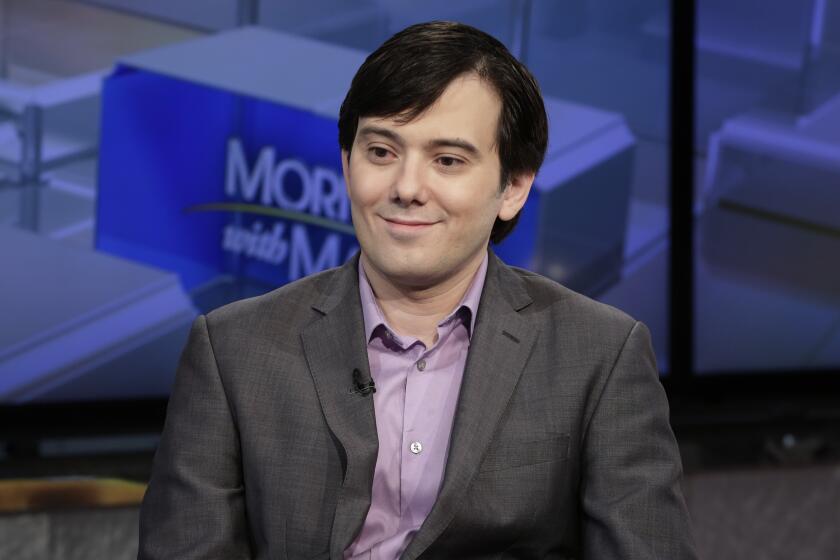Recession could last into 2010
The economy’s yearlong downturn, officially declared a recession Monday, could last well into next year or even beyond, challenging the government to devise new responses as traditional methods show limited results.
The National Bureau of Economic Research, the private body charged with determining the onset of a recession as well as its endpoint, said Monday that the current downturn met its definition of a recession: “a significant decline in economic activity spread across the economy, lasting more than a few months.”
The downturn began, the bureau said, at the end of last year as businesses started slashing jobs -- which they have done every month this year.
The group did not say how long the recession might last, but the stock market reflected widespread pessimism. After a widely followed index of U.S. manufacturing activity fell to its lowest level in 26 years, the Dow Jones industrials tumbled 679 points, or 7.7%, and the Standard & Poor’s 500 index plunged 8.9%.
“This downturn promises to be the worst since the Great Depression in the 1930s,” said Joshua Shapiro, chief U.S. economist at forecasting firm MFR Inc. “We’ve only just started. I can’t see bottoming out until sometime in 2010.”
The slide in stock prices ended a five-day rally, the market’s strongest in seven decades, built on hope that the incoming administration of President-elect Barack Obama could turn the economy around.
“The market got ahead of itself last week,” said Scott Anderson, senior economist with Wells Fargo & Co. in Minneapolis. “But we’re back into our funk again. The fundamentals of the economy still look like things are going to weaken still further over the next few months.”
A psychology of fear has gripped businesses and consumers and is likely to prolong the recession, said Lee Ohanian, a professor of economics at UCLA.
“This one has a potential to be longer and deeper than other postwar recessions,” he said. “People are very, very scared and worried. In my opinion the government has created much more uncertainty about the economy than it should have done. So it’s really hard to tell how long this recession could last.”
Government officials reiterated that they would do what was required to turn the economy around.
“While we are making progress, the journey ahead will continue to be a difficult one,” Treasury Secretary Henry M. Paulson said.
Federal Reserve Chairman Ben S. Bernanke, addressing the Austin, Texas, Chamber of Commerce, pledged to use the central bank’s full resources to repair the credit markets and prime the economy.
But “despite the efforts of the Federal Reserve and other policymakers,” he said, “the U.S. economy remains under considerable stress.”
Although the Fed has lowered its benchmark interest rate to only 1%, a very low level by historical measures, Bernanke said it could be lowered further. However, that rate doesn’t directly affect long-term rates paid by borrowers. As a result, the Fed is considering purchasing Treasury bonds on the open market, a move that could bring down long-term borrowing costs.
“I am not suggesting the way forward will be easy,” Bernanke said. “But I believe that the policy responses taken here . . . will help to restore confidence in our financial system and place our economy back on the path to vigorous growth.”
The National Bureau of Economic Research, a nonprofit, nonpartisan group, was founded in 1920 to study the economy and formally designate each business cycle’s peak -- when an economic expansion gives way to a recession -- as well as each trough -- when growth resumes after a downturn.
Since 1978, the group has had a special committee in charge of the designation process.
Although a recession is commonly defined as two consecutive quarters of declines in the gross domestic product -- a measure of all goods and services produced -- the current downturn doesn’t meet that yardstick.
The GDP shrank in this year’s third quarter at a 0.5% annual rate but showed growth of 2.8% in the second quarter and 0.9% in the first quarter.
The bureau, however, uses a larger variety of indicators, including monthly measures of employment, industrial production and personal income.
Economists say that’s because GDP figures can mask economic woes. For instance, if firms are producing goods, GDP will go up even if no one is buying them and they are simply going into inventories.
Sung Won Sohn, a professor at Cal State Channel Islands, said the economy would probably have shown two straight quarters of shrinking GDP this year if the government hadn’t handed out tax rebates as part of an economic stimulus program.
“The rebates resulted in a blip in the second quarter, and now that blip is gone,” he said.
Job losses appeared to weigh most heavily in the bureau’s decision.
The economy normally must create about 100,000 jobs a month to keep pace with population growth. But lately job creation has been in reverse. Through October, an average of 120,000 jobs a month have been lost this year. The unemployment rate stood at 6.5% in October, and many economists expect the rate to top 8% next year.
“The committee found that economic activity measured by production was close to flat from roughly September 2007 to roughly June 2008, while activity measured by employment reached a clear peak in December 2007,” the bureau said.
The organization’s economists “judged that the weight of the evidence” suggested that the economy peaked -- and the recession began -- in December 2007.
--
More to Read
Inside the business of entertainment
The Wide Shot brings you news, analysis and insights on everything from streaming wars to production — and what it all means for the future.
You may occasionally receive promotional content from the Los Angeles Times.










